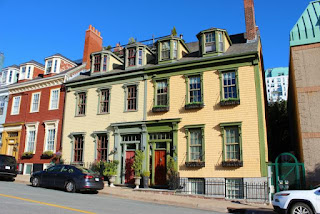Our attempt to dock in St. Johns,
Newfoundland was spoiled by heavy fog and a very narrow opening at the harbor
entrance. We had mixed emotions. While it would’ve been nice to dock and get
off the ship for a few hours, we were BOTH ready for warmer weather. After 30-plus days of generally miserable
conditions, it was definitely time!! Don’t take me wrong – escaping from the
Arizona heat was truly wonderful but the continual fog (almost daily) put us
both down. The Captain was very apologetic when he announced the cancellation
of St. Johns, but we suspect there were several hundred other folks who were as
happy as we were.
So…it was off to our next port
and as the Captain described it…a very nice, WARM destination in Canada known
as Halifax!
It was time to pack our winter
clothing and break out the shorts again! Because we cancelled our stop in St.
Johns, our schedule was a little mixed up, and we rolled into Halifax about 18
hours early – at 2pm. The sun was out, temps were in the low 70’s, and the
harbor was rocking with pleasure boats. We were both very tired and since we
weren’t scheduled to leave Halifax until 10pm the following evening, we sat out
on our veranda and watched all the activity taking place.
Up at 6am, we had a good
breakfast, and were off the ship by 7:00.
Halifax is the capital of the
Canadian province of Nova Scotia. It had a population of about 403,000 in 2016,
with 316,000 in the urban area center on Halifax Harbor. It’s also a major
economic center in Atlantic Canada, with a large concentration of government
services and private sector companies. Major employers and economic generators
include the Department of National Defense, Dalhousie University, Saint Mary's
University, the Halifax Shipyard, various levels of government, and the Port of
Halifax. Agriculture, fishing, mining, forestry and natural gas extraction are
major resource industries found in the rural areas of the municipality.
December 1917 saw one of the
greatest disasters in Canadian history, when the SS Mont-Blanc, a French
cargo ship carrying munitions, collided with the Belgian Relief vessel
SS Imo in "The Narrows" between upper Halifax Harbor and Bedford
Basin. The resulting explosion, the Halifax Explosion, devastated the Richmond
District of Halifax, killing approximately 2,000 people and injuring nearly
9,000 others. The blast was the largest artificial explosion before the
development of nuclear weapons. Significant aid came from Boston, strengthening
the bond between the two coastal cities
The urban area of Halifax is a
major economic center in eastern Canada with a large concentration of
government services and private sector companies. Halifax serves as the
business, banking, government and cultural center for the Maritime region. The
largest employment sectors in the city include trade jobs, health care and
social assistance, professional services, education, and public administration.
Shipbuilding is a major employer
in Halifax. Irving has a huge plant employing several thousand, though I‘m not
sure of the exact count.
Agriculture, fishing, mining,
forestry and natural gas extraction are major resource industries found in the
rural areas of the municipality. Halifax's largest agricultural district is in
the Musquodoboit Valley; the total number of farms in Halifax is 150, of which
110 are family-owned. Fishing harbors are located along all coastal areas with
some having an independent harbor authority, such as the Sheet Harbor
Industrial Port and others being managed as small craft harbors under the
federal Fisheries and Oceans Canada.
We were out exploring this
fascinating city for nearly 12 hours!





























































